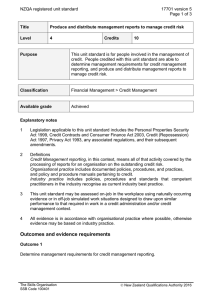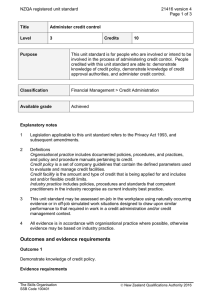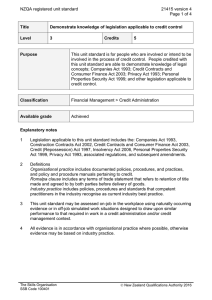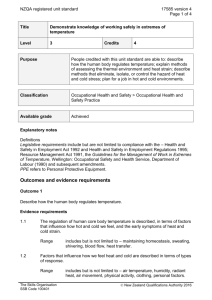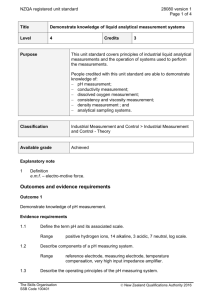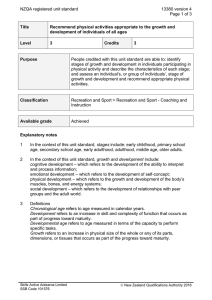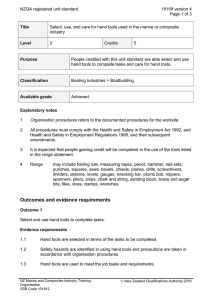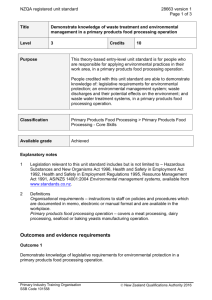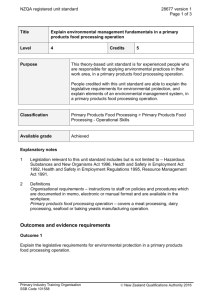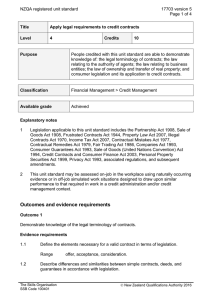NZQA registered unit standard 16407 version 5 Page 1 of 4
advertisement
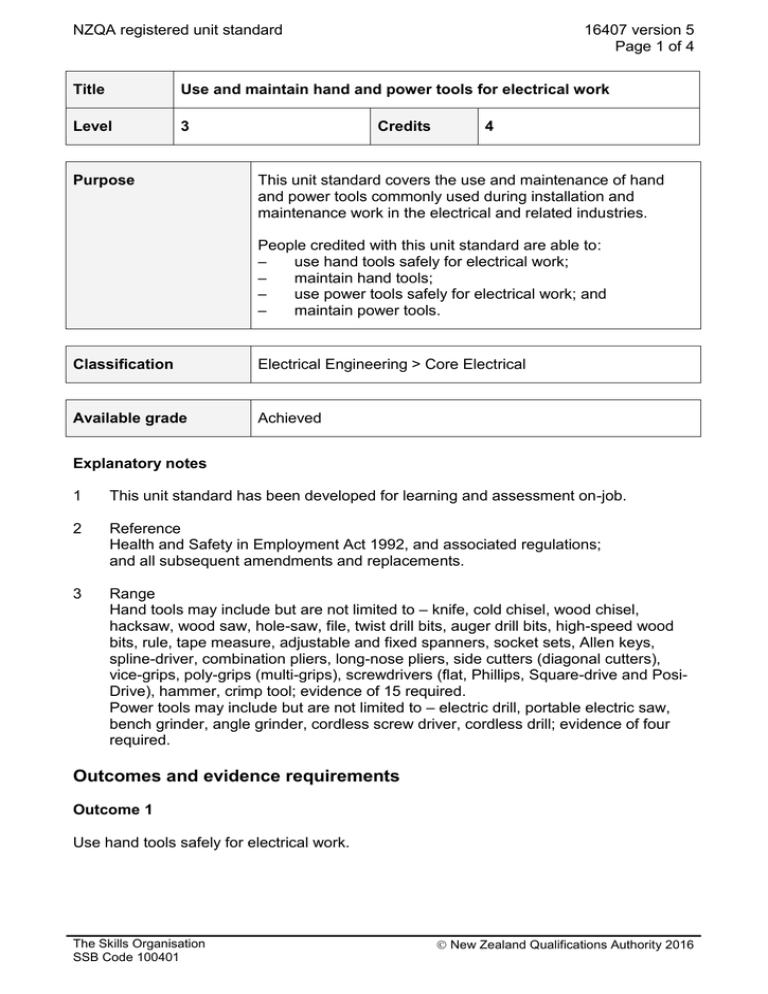
NZQA registered unit standard 16407 version 5 Page 1 of 4 Title Use and maintain hand and power tools for electrical work Level 3 Purpose Credits 4 This unit standard covers the use and maintenance of hand and power tools commonly used during installation and maintenance work in the electrical and related industries. People credited with this unit standard are able to: – use hand tools safely for electrical work; – maintain hand tools; – use power tools safely for electrical work; and – maintain power tools. Classification Electrical Engineering > Core Electrical Available grade Achieved Explanatory notes 1 This unit standard has been developed for learning and assessment on-job. 2 Reference Health and Safety in Employment Act 1992, and associated regulations; and all subsequent amendments and replacements. 3 Range Hand tools may include but are not limited to – knife, cold chisel, wood chisel, hacksaw, wood saw, hole-saw, file, twist drill bits, auger drill bits, high-speed wood bits, rule, tape measure, adjustable and fixed spanners, socket sets, Allen keys, spline-driver, combination pliers, long-nose pliers, side cutters (diagonal cutters), vice-grips, poly-grips (multi-grips), screwdrivers (flat, Phillips, Square-drive and PosiDrive), hammer, crimp tool; evidence of 15 required. Power tools may include but are not limited to – electric drill, portable electric saw, bench grinder, angle grinder, cordless screw driver, cordless drill; evidence of four required. Outcomes and evidence requirements Outcome 1 Use hand tools safely for electrical work. The Skills Organisation SSB Code 100401 New Zealand Qualifications Authority 2016 NZQA registered unit standard 16407 version 5 Page 2 of 4 Evidence requirements 1.1 Hand tools are selected according to work requirements. Range may include but is not limited to – tool function, length, weight, opening width, blade width, tool type; work requirements – size and type of material, risk of damage to the work. 1.2 Hand tools are used safely and in accordance with industry practice. 1.3 Additional precautions are taken when hand tools are used near live equipment, ensuring they are adequately insulated. Outcome 2 Maintain hand tools. Evidence requirements 2.1 Hand tools are maintained according to industry practice in terms of cleaning, lubricating, sharpening, storage, and protection against damage. 2.2 Hand tools are regularly inspected for signs of wear and repaired or discarded when damaged, according to industry practice. Outcome 3 Use power tools safely for electrical work. Evidence requirements 3.1 Power tools are checked for safety and wear prior to use according to industry practice. Range checks typically include but are not limited to – frayed or damaged flexible cords, integrity of appliance connector or plug tops, pins straight, screws tight, cord grips functioning, integrity of casings, screws tight, missing parts, damaged components, lubrication. 3.2 Power tools are selected for cutting and drilling applications to match the size, nature, and environment of the task to be performed. 3.3 Power tools are used according to manufacturer's specifications and industry practice, without damage to the tool or the material on which they are used and in accordance with safety requirements. 3.4 Isolating transformers or residual current devices are used with tools operating at mains voltage. The Skills Organisation SSB Code 100401 New Zealand Qualifications Authority 2016 NZQA registered unit standard 16407 version 5 Page 3 of 4 Outcome 4 Maintain power tools. Evidence requirements 4.1 Power tools are kept in a state of good repair and protected from damage according to industry practice and manufacturer's recommendations. 4.2 Cords and, where appropriate, pneumatic hoses are coiled and stored in a manner that avoids strain, twists, and kinks. Replacement information This unit standard replaced unit standard 1175 and unit standard 5914. Planned review date 31 December 2014 Status information and last date for assessment for superseded versions Process Version Date Last Date for Assessment Registration 1 28 June 1999 31 December 2013 Revision 2 3 April 2001 31 December 2013 Review 3 26 May 2005 N/A Rollover and Revision 4 15 March 2012 N/A Revision 5 15 January 2014 N/A Consent and Moderation Requirements (CMR) reference 0003 This CMR can be accessed at http://www.nzqa.govt.nz/framework/search/index.do. Please note Providers must be granted consent to assess against standards (accredited) by NZQA, before they can report credits from assessment against unit standards or deliver courses of study leading to that assessment. Industry Training Organisations must be granted consent to assess against standards by NZQA before they can register credits from assessment against unit standards. Providers and Industry Training Organisations, which have been granted consent and which are assessing against unit standards must engage with the moderation system that applies to those standards. The Skills Organisation SSB Code 100401 New Zealand Qualifications Authority 2016 NZQA registered unit standard 16407 version 5 Page 4 of 4 Requirements for consent to assess and an outline of the moderation system that applies to this standard are outlined in the Consent and Moderation Requirements (CMR). The CMR also includes useful information about special requirements for organisations wishing to develop education and training programmes, such as minimum qualifications for tutors and assessors, and special resource requirements. Comments on this unit standard Please contact The Skills Organisation reviewcomments@skills.org.nz if you wish to suggest changes to the content of this unit standard. The Skills Organisation SSB Code 100401 New Zealand Qualifications Authority 2016

